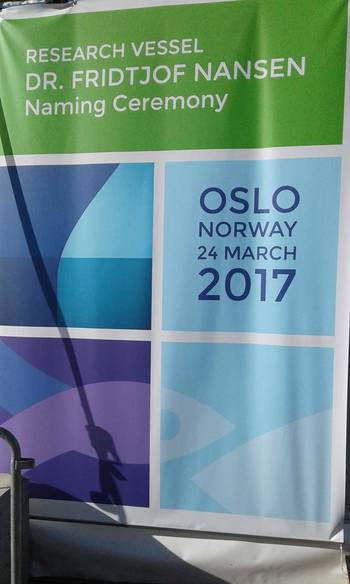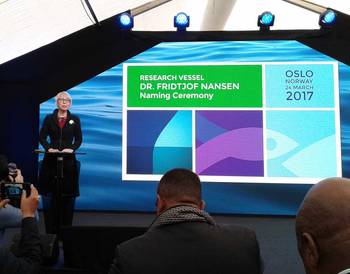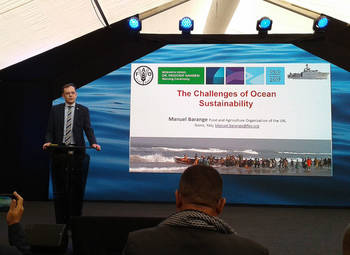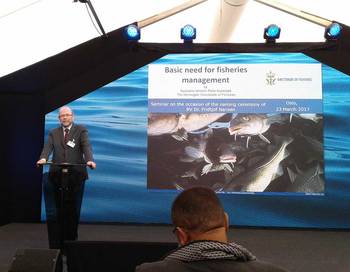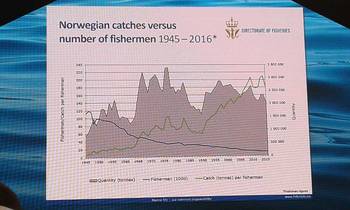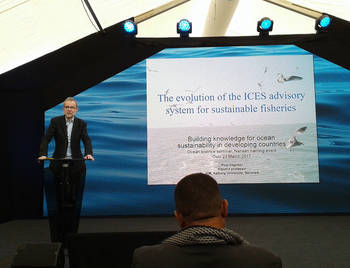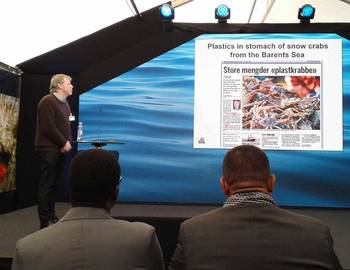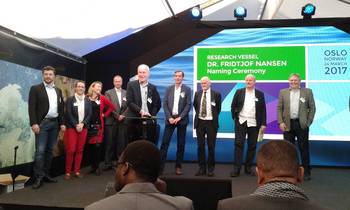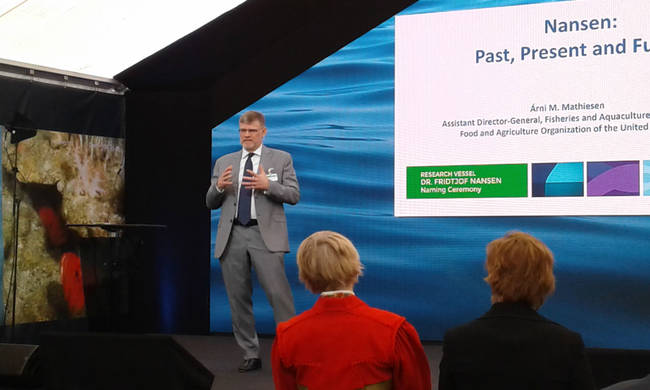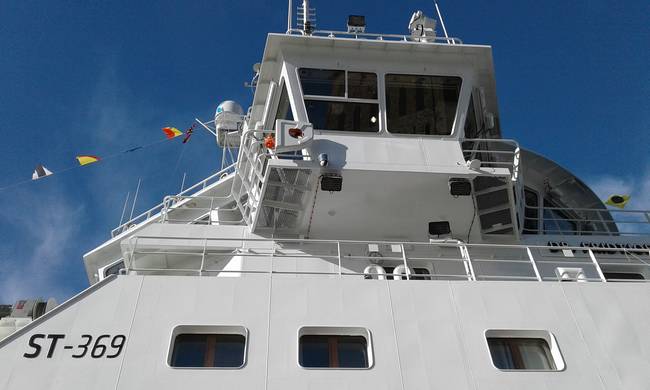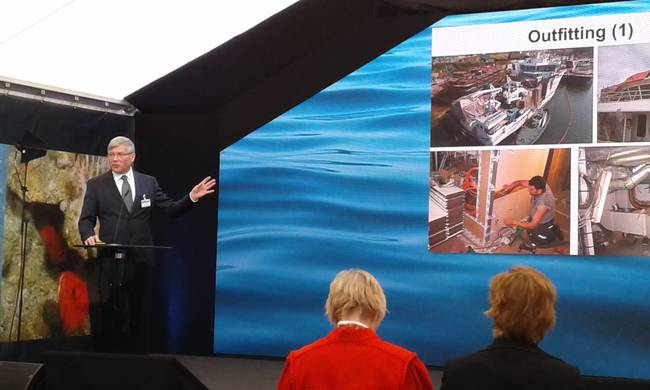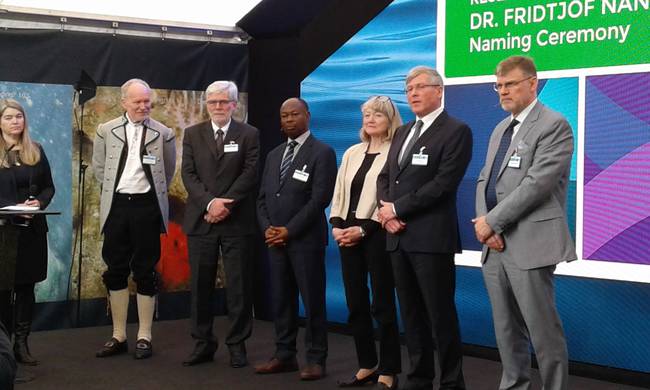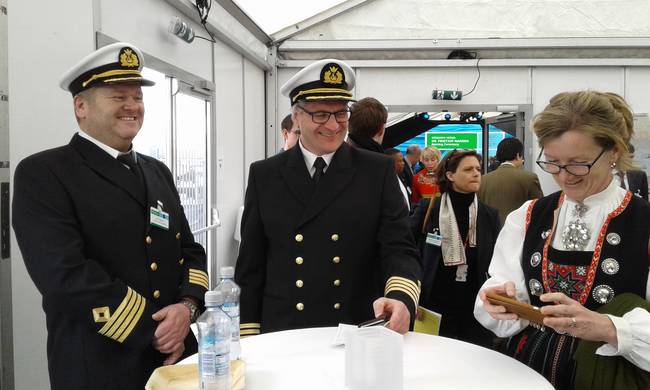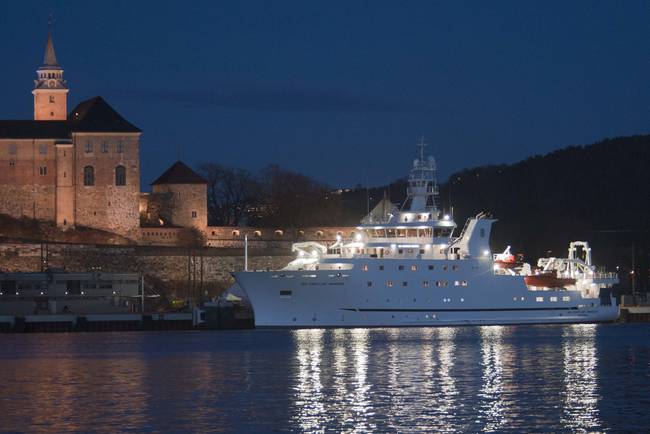Oslo seminars dedicated to the science behind the new Nansen vessel
The new marine research vessel, the R/V Dr Fridtjof Nansen, was officially launched at the Akerhus Pier in Oslo, Norway on Friday afternoon, 24 March.
If you missed our blog post about the tour on board this new vessel – the most technologically advanced marine research vessel in the world – you can read that here.
Thursday and Friday morning brought together and international group of scientists and government officials to discuss the science behind the 43-year-old partnership between the Government of Norway and FAO, and the chance to outline next steps of this Nansen programme.
Sissel Rogne, Managing Director of Norway’s Institute of Marine Research (IMR), welcomed participants, calling the new Nansen vessel “a unique gift from the Government of Norway to the world.” According to Rogne, the work of the Nansen is in keeping with the vessel’s namesake, the intrepid Arctic explorer, scientist and Nobel laureate, who was also a humanitarian – a supporter of the League of Nations and the head of the precursor to the United Nations High Commission on Refugees. Take a look here to see a blog post with a brief background on Nansen’s life.
Rogne adds, “It is in keeping with the spirit of Fridtjof Nansen – perhaps one of Norway’s greatest men – that we embarked on this Nansen Project over forty years ago, alongside the Food and Agriculture Organization of the United Nations. Like the man, this Nansen project combines science, ocean exploration and humanitarian needs – working together with all nations of the world to care for our oceans.”
FAO Fisheries and Aquaculture Policy and Resources Division Director Manuel Barange recalled how, as a young doctoral student, he first took part on the first of five of his Nansen survey voyage. “At the time, political tensions between South Africa, Angola and Namibia created distance between those countries and their research scientists. The joint survey voyage was extraordinary, because it was designed to build bridges between scientists from those three nations, working together on board to improve their approach to joint fisheries management. It was a remarkable opportunity.”
Barange presented FAO data on fisheries, noting that 31% of stocks are overfished – a trend that has been increasing over time, and one which must be reversed. He also reminded participants about FAO’s role in negotiating binding and non-binding agreements designed to improve fisheries management and livelihoods for fishers and coastal communities, pointing to the FAO Port State Measures Agreement now in effect as a key instrument to combat illegal fishing. Barange thanked Norway for its strong support in assisting countries to implement the Port State Measures Agreement, and its hosting of the treaty’s first inception meeting in Oslo this May.
Peter Gullestad, Senior Adviser of the Norwegian Directorate of Fisheries spoke about the radical shifts in fisheries management in his country over the past fifty years. A half decade ago, Norway viewed fisheries primarily through the lens of employment generation and rural settlement. Today, ecological concerns and maintaining a profitable fleet without subsidies are the main priorities. “Fisheries management is a complex, multidisciplinary business,” he told conference attendees.
Aalborg University Professor Paul Degnbol agreed heartily with that assessment, and reflected on the need to cut across disciplines. “Unfortunately, we find that fisheries and environmental policies live in different silos, with entirely separate legislation and institutions. This is a challenge to achieving sustainable fisheries management.”
Country presentations highlighted the interesting work undertaken during survey cruises in Africa under the last phase of the Nansen. A series of scientific presentations discussed a wide range of topics ranging from the impact of climate change and variability on ecosystems, ocean acidification, the use of genetics and environmental DNA, to concerns about microplastics in our oceans.
Gabriella Bianchi, Nansen Research Coordinator explained the next phase of the Nansen, with its new focus – in addition to its traditional fisheries management work - on issues related to climate change, pollution from oil and gas, and its study of marine plastics in our oceans.
At Friday morning’s session, Árni M. Mathiesen, FAO’s Assistant Director-General for Fisheries and Aquaculture thanked the Norwegians for their generous support of the Nansen programme. “When I was a boy growing up in Iceland, Fridtjof Nansen’s biography was part of a series of books for children about the men and women who changed the world. It is fitting that this ship was named for a man of so many talents, one who was so engaged with the world around him. Despite all our advances today, in many respects, our modern times are not so different from the time in which Nansen lived. Today, we witness refugee crises at the highest levels since the World Wars, and linked to this we face immense challenges linked to hunger and food insecurity. Furthermore, we confront political unrest and instability throughout entire regions, and even challenges unknown during Nansen’s time – such as climate change and the stresses that places on our natural resources. Through this programme, we are working to solve these problems very much in the spirit of Fridtjof Nansen.”
“Our point of departure is supporting sustainable management of natural resources in developing countries and linking this closely to FAO’s work of capacity development and achieving food security. We thank Norway for its decades-long commitment to this unique programme.”
The IMR’s Tøre Stromme and FAO’s Kwame Koranteng reviewed the 43-year-old history of the Nansen project, Norad’s longest running project. Korateng also stressed the gender programme of the Nansen, which brings many women scientists and technicians aboard to work on the Nansen during its survey cruises.
IMR’s Director of the Research Vessel Department, Per Nieuwejaar, oversaw the entire process of constructing this vessel – from the design phase to the shipbuilding in the ship yards of Vigo, Spain, to the vessel launch off the Spanish coast and its journey back home to Norway, where it underwent sea testing. “I am extremely pleased to stand before you today to speak about the merits of combined Norwegian design and technology and Spanish craftsmanship and shipbuilding skills.
This is a Rolls Royce of a research vessel, and for those of you who are not familiar with the challenges of research vessel construction, I can ensure you it is extremely complicated.”
At the end of the session and before moving outside to the naming ceremony, IMR’s Director Åsmund Bjordal wrapped up the discussions well, also noting that “even the new Nansen, the most advanced marine research vessel of its kind today, is worth nothing without the crew and scientists who work aboard it.
We are lucky to have that, and we look forward to many years of successful work ahead of us on this new Nansen.”


